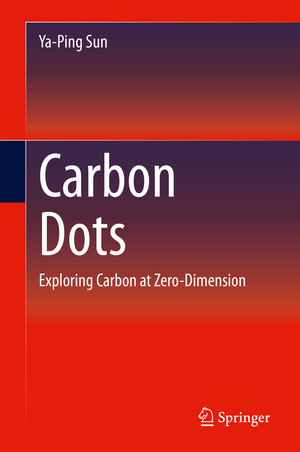Carbon Dots: Exploring Carbon at Zero-Dimension
Autor Ya-Ping Sunen Limba Engleză Hardback – 2 apr 2020
| Toate formatele și edițiile | Preț | Express |
|---|---|---|
| Paperback (1) | 710.88 lei 43-57 zile | |
| Springer International Publishing – 2 apr 2021 | 710.88 lei 43-57 zile | |
| Hardback (1) | 984.43 lei 43-57 zile | |
| Springer International Publishing – 2 apr 2020 | 984.43 lei 43-57 zile |
Preț: 984.43 lei
Preț vechi: 1200.52 lei
-18% Nou
Puncte Express: 1477
Preț estimativ în valută:
188.46€ • 193.82$ • 156.34£
188.46€ • 193.82$ • 156.34£
Carte tipărită la comandă
Livrare economică 17 februarie-03 martie
Preluare comenzi: 021 569.72.76
Specificații
ISBN-13: 9783030411831
ISBN-10: 3030411834
Ilustrații: VIII, 209 p. 154 illus., 96 illus. in color.
Dimensiuni: 155 x 235 mm
Greutate: 0.49 kg
Ediția:1st ed. 2020
Editura: Springer International Publishing
Colecția Springer
Locul publicării:Cham, Switzerland
ISBN-10: 3030411834
Ilustrații: VIII, 209 p. 154 illus., 96 illus. in color.
Dimensiuni: 155 x 235 mm
Greutate: 0.49 kg
Ediția:1st ed. 2020
Editura: Springer International Publishing
Colecția Springer
Locul publicării:Cham, Switzerland
Cuprins
Introduction.- Background Knowledge.- Carbon Dots.- Carbon-based Quantum Dots.- Technological Applications.- Further Opportunities.
Notă biografică
Dr. Sun received his B.Eng. (1982) from the Zhejiang Institute of Technology and his M.S. (1985) from the Zhejiang University, both in Hangzhou, China. He earned his Ph.D. (1989) at the Florida State University with Prof. Jack Saltiel. He was a postdoctoral fellow with Prof. Josef Michl (1989-91) and Prof. Marye Anne Fox (1991-92) at the University of Texas at Austin. He joined the Clemson faculty as an assistant professor in 1992, was promoted to associate professor with tenure and full professor in 1996 and 1999, respectively, and became an endowed chair professor in 2003. Carbon dots were found by Sun research group at Clemson University, and were reported (after patent applications) in a 2006 paper. Since then, the research field of carbon dots has emerged, and the field has been advancing and expanding rapidly, as has been made evident by the fact that the aforementioned paper has been cited for more than 2,700 times.
Textul de pe ultima copertă
Written by the founder of the field of carbon “quantum” dots (carbon dots) and related technology, this book outlines the principles of carbon dots and presents strong evidence for that small carbon nanoparticles and by extension carbon dots represent the nanoscale carbon allotrope at zero-dimension. Historical accounts of the inception and evolution of the carbon dots field are provided. Experimental approaches and techniques for the dot synthesis and some related major issues are discussed in detail. The photoexcited state properties, especially the bright and colorful photoluminescence emissions, and photoinduced redox characteristics of carbon dots are presented, and so are their advantages over semiconductor quantum dots as well as fullerenes. Carbon dots are also compared with “graphene quantum dots”, for which a unified mechanistic understanding is proposed. Finally, a broad range of applications of carbon dots and their derived hybrid nanostructures in biomedical, renewable energy, food and environmental safety, and other technologies are highlighted. The book concludes with a discussion on the excellent potential and opportunities for further research and development.
Caracteristici
Provides an authoritative, accurate, and comprehensive description on the fundamentals, properties, and potential of carbon dots, including a comparison with conventional semiconductor quantum dots and other quantum dot-like nanomaterials Highlights near-term and future major technological applications of carbon dots (targeting readers from various industrial groups) Presents a comprehensive view on the major opportunities and challenges in the further development of carbon dots and derived technologies
